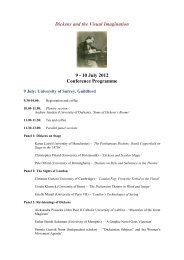The targeted killing of terrorists on foreign soil - Institute of Advanced ...
The targeted killing of terrorists on foreign soil - Institute of Advanced ...
The targeted killing of terrorists on foreign soil - Institute of Advanced ...
Create successful ePaper yourself
Turn your PDF publications into a flip-book with our unique Google optimized e-Paper software.
Tobias Ruettersh<str<strong>on</strong>g>of</str<strong>on</strong>g>f<br />
Panel 4 (a)<br />
<str<strong>on</strong>g>The</str<strong>on</strong>g> involved states obviously have no interest in mandating <str<strong>on</strong>g>targeted</str<strong>on</strong>g> <str<strong>on</strong>g>killing</str<strong>on</strong>g> operati<strong>on</strong>s under<br />
a law-enforcement model, as there is <str<strong>on</strong>g>of</str<strong>on</strong>g>ten an “unusual, and at times insurmountable obstacle<br />
to indicting them” (Meisels 2004, 304). <str<strong>on</strong>g>The</str<strong>on</strong>g> ability to build a str<strong>on</strong>g case against a suspected<br />
terrorist, proving him guilty bey<strong>on</strong>d a reas<strong>on</strong>able doubt is inherently difficult. Verifying a<br />
suspect’s identity, his c<strong>on</strong>necti<strong>on</strong> to a particular terrorist organisati<strong>on</strong>, and the direct<br />
resp<strong>on</strong>sibility for terrorist attacks in compliance with the strict legal requirements <str<strong>on</strong>g>of</str<strong>on</strong>g> the<br />
criminal justice system remain unsure (ibid., 304). Suspects in custody are an additi<strong>on</strong>al<br />
problem for the states. Juries and witnesses may be intimidated by the <str<strong>on</strong>g>terrorists</str<strong>on</strong>g>, making the<br />
trial even more problematic (see Finn 1991, 99). <str<strong>on</strong>g>The</str<strong>on</strong>g> detenti<strong>on</strong> <str<strong>on</strong>g>of</str<strong>on</strong>g> <str<strong>on</strong>g>terrorists</str<strong>on</strong>g> may also lead to<br />
further attacks or hostage-takings to enforce their release (see Mach<strong>on</strong> 2006, 40).<br />
Furthermore, the military <str<strong>on</strong>g>of</str<strong>on</strong>g>ten resists the law-enforcement model because the attempt to<br />
arrest <str<strong>on</strong>g>terrorists</str<strong>on</strong>g> can be very costly in terms <str<strong>on</strong>g>of</str<strong>on</strong>g> casualties. <str<strong>on</strong>g>The</str<strong>on</strong>g> American raid to apprehend<br />
Somali warlord Mohammed Farrah Aidid in Mogadishu, <strong>on</strong> October 3 rd , 1993 illustrates<br />
some <str<strong>on</strong>g>of</str<strong>on</strong>g> the potential dangers <str<strong>on</strong>g>of</str<strong>on</strong>g> this model. <str<strong>on</strong>g>The</str<strong>on</strong>g>refore, states opine that <str<strong>on</strong>g>targeted</str<strong>on</strong>g> <str<strong>on</strong>g>killing</str<strong>on</strong>g>s<br />
have to be seen under a war paradigm, where internati<strong>on</strong>al humanitarian law gives more<br />
leeway than human rights law under the law-enforcement paradigm. <str<strong>on</strong>g>The</str<strong>on</strong>g> central argument is<br />
that terrorist organisati<strong>on</strong>s have military abilities and means which can <strong>on</strong>ly be countered<br />
with state military measures.<br />
Indeed, the acti<strong>on</strong>s <str<strong>on</strong>g>of</str<strong>on</strong>g> individual <str<strong>on</strong>g>terrorists</str<strong>on</strong>g> and terrorist organisati<strong>on</strong>s and the violence they<br />
inflict, go far bey<strong>on</strong>d that <str<strong>on</strong>g>of</str<strong>on</strong>g> ordinary criminals. Nearly 3,000 Americans died in the terrorist<br />
attacks <str<strong>on</strong>g>of</str<strong>on</strong>g> September 11 th (see Glazier 2008). Israel has lost over 900 citizens in the first five<br />
years <str<strong>on</strong>g>of</str<strong>on</strong>g> the Sec<strong>on</strong>d Intifada (see Israeli Supreme Court 2006, para. 16). In their attacks, “the<br />
terrorist organisati<strong>on</strong>s use military means par excellence, whereas the comm<strong>on</strong> denominator<br />
<str<strong>on</strong>g>of</str<strong>on</strong>g> them all is their lethalness and cruelty. Am<strong>on</strong>g those means are shooting attacks, suicide<br />
bombings, mortar fire, rocket fire, car bombs, et cetera” (ibid., para. 16). Law-enforcement<br />
authorities cannot deal with those kinds <str<strong>on</strong>g>of</str<strong>on</strong>g> threats anymore. Moreover, they can <str<strong>on</strong>g>of</str<strong>on</strong>g>ten not<br />
operate in <strong>foreign</strong> countries, particularly if it is a failed state. Instead, military means have to<br />
be employed, inter alia to kill <str<strong>on</strong>g>terrorists</str<strong>on</strong>g> via <str<strong>on</strong>g>targeted</str<strong>on</strong>g> <str<strong>on</strong>g>killing</str<strong>on</strong>g>. In sum, the war model is the<br />
prime basis for the legality assessment and not the law-enforcement model. Although the<br />
latter <strong>on</strong>e implies human rights law, it is too domestic in nature to apply to the fight against<br />
internati<strong>on</strong>al terrorism and does not allow appropriate means.<br />
- 9 -
















